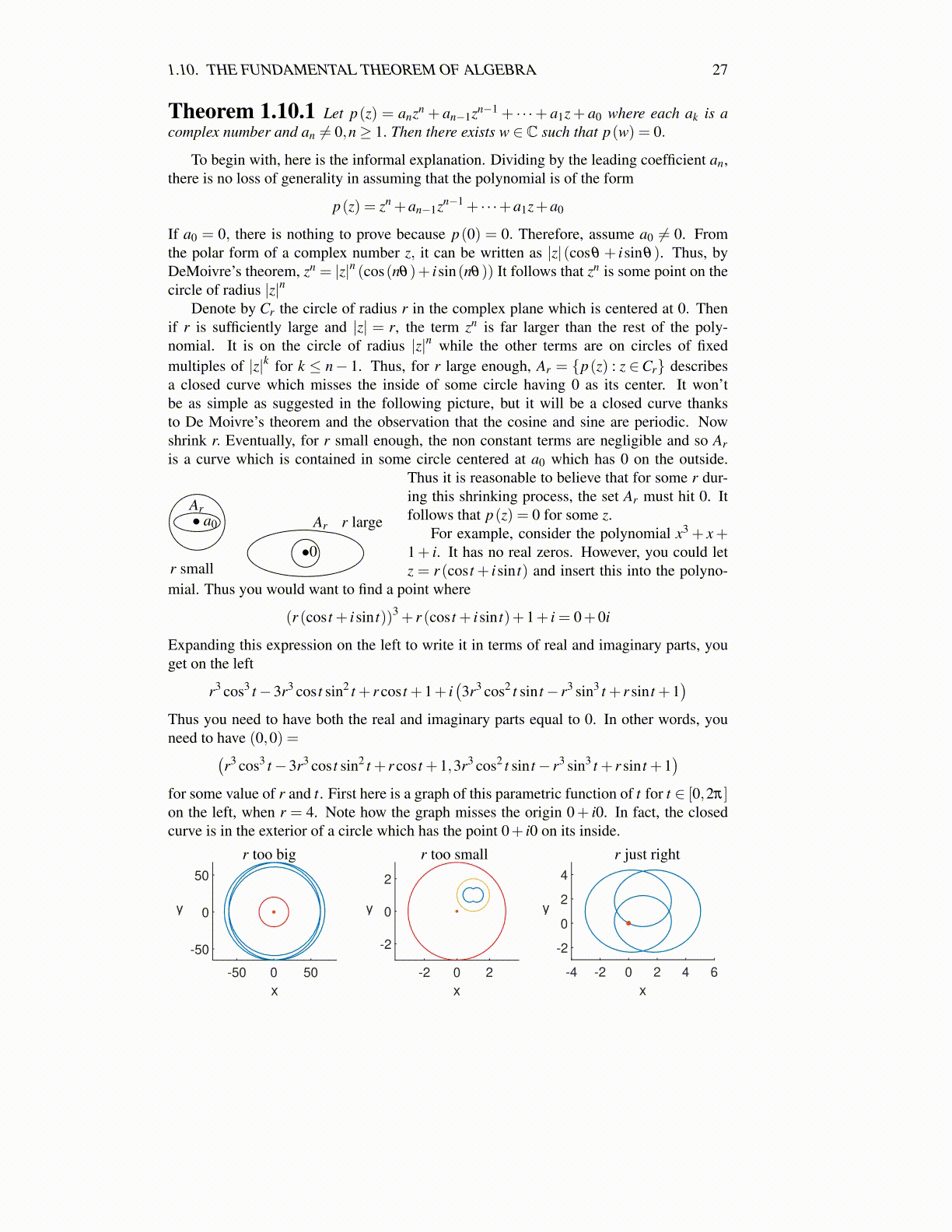
1.10. THE FUNDAMENTAL THEOREM OF ALGEBRA 27
Theorem 1.10.1 Let p(z) = anzn + an−1zn−1 + · · ·+ a1z+ a0 where each ak is acomplex number and an ̸= 0,n≥ 1. Then there exists w ∈ C such that p(w) = 0.
To begin with, here is the informal explanation. Dividing by the leading coefficient an,there is no loss of generality in assuming that the polynomial is of the form
p(z) = zn +an−1zn−1 + · · ·+a1z+a0
If a0 = 0, there is nothing to prove because p(0) = 0. Therefore, assume a0 ̸= 0. Fromthe polar form of a complex number z, it can be written as |z|(cosθ + isinθ). Thus, byDeMoivre’s theorem, zn = |z|n (cos(nθ)+ isin(nθ)) It follows that zn is some point on thecircle of radius |z|n
Denote by Cr the circle of radius r in the complex plane which is centered at 0. Thenif r is sufficiently large and |z| = r, the term zn is far larger than the rest of the poly-nomial. It is on the circle of radius |z|n while the other terms are on circles of fixedmultiples of |z|k for k ≤ n− 1. Thus, for r large enough, Ar = {p(z) : z ∈Cr} describesa closed curve which misses the inside of some circle having 0 as its center. It won’tbe as simple as suggested in the following picture, but it will be a closed curve thanksto De Moivre’s theorem and the observation that the cosine and sine are periodic. Nowshrink r. Eventually, for r small enough, the non constant terms are negligible and so Aris a curve which is contained in some circle centered at a0 which has 0 on the outside.
•0
Ar r large• a0
Ar
r small
Thus it is reasonable to believe that for some r dur-ing this shrinking process, the set Ar must hit 0. Itfollows that p(z) = 0 for some z.
For example, consider the polynomial x3 + x+1+ i. It has no real zeros. However, you could letz = r (cos t + isin t) and insert this into the polyno-
mial. Thus you would want to find a point where
(r (cos t + isin t))3 + r (cos t + isin t)+1+ i = 0+0i
Expanding this expression on the left to write it in terms of real and imaginary parts, youget on the left
r3 cos3 t−3r3 cos t sin2 t + r cos t +1+ i(3r3 cos2 t sin t− r3 sin3 t + r sin t +1
)Thus you need to have both the real and imaginary parts equal to 0. In other words, youneed to have (0,0) =(
r3 cos3 t−3r3 cos t sin2 t + r cos t +1,3r3 cos2 t sin t− r3 sin3 t + r sin t +1)
for some value of r and t. First here is a graph of this parametric function of t for t ∈ [0,2π]on the left, when r = 4. Note how the graph misses the origin 0+ i0. In fact, the closedcurve is in the exterior of a circle which has the point 0+ i0 on its inside.
-50 0 50
x
-50
0
50
y
-2 0 2
x
-2
0
2
y
-4 -2 0 2 4 6
x
-2
0
2
4
y
r too big r too small r just right